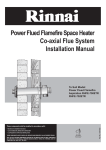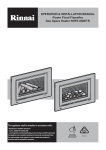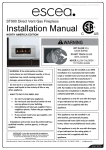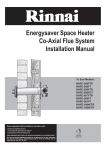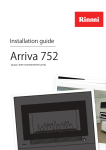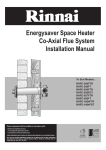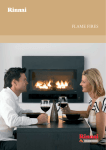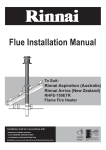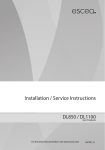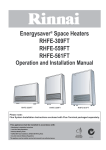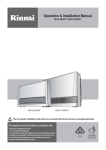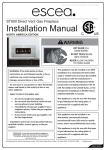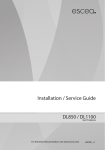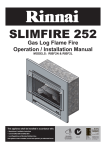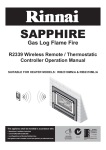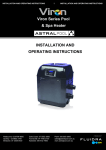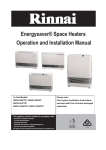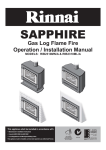Download Rinnai RHFE-750ETR Installation manual
Transcript
INSTALLATION MANUAL Power Flued Flamefire Space Heater Co-axial Flue System To Suit Power Flued Flamefire Models: RHFE-750ETR - ASPIRATION RHFE-752ETR RHFE-950ETR • Manufacturer’s Installation Instructions • Current AS/NZS 5601 AS/NZS 3000 • Local Regulations and Municipal Building Codes including local OH&S requirements This appliance must be installed, maintained and removed by an Authorised Person. For continued safety of this appliance it must be installed and maintained in accordance with the manufacturers instructions. All Rinnai gas products are A.G.A. certified. Part No. 15401082 This appliance shall be installed in accordance with: TABLE OF CONTENTS CONVENTIONS USED IN THIS MANUAL . . . . . . . . . . . . . . . . . . . . . . . . . . . . . . . . . . . . . . . . . . . . . . . . . . . . . . . . 3 REGULATIONS, CLEARANCES & GENERAL INFORMATION . . . . . . . . . . . . . . . . . . . . . . . . . . . . . . . . . . . . . . . 4 FLUE TRANSITION CONNECTIONS . . . . . . . . . . . . . . . . . . . . . . . . . . . . . . . . . . . . . . . . . . . . . . . . . . . . . . . . . 5 LOCATION . . . . . . . . . . . . . . . . . . . . . . . . . . . . . . . . . . . . . . . . . . . . . . . . . . . . . . . . . . . . . . . . . . . . . . . . . . . . . . 5 LUBRICATING INNER PIPE COMPONENTS . . . . . . . . . . . . . . . . . . . . . . . . . . . . . . . . . . . . . . . . . . . . . . . . . . . 5 INSTALLATION CONFIGURATIONS . . . . . . . . . . . . . . . . . . . . . . . . . . . . . . . . . . . . . . . . . . . . . . . . . . . . . . . . . . . . 6 WALL PENETRATIONS . . . . . . . . . . . . . . . . . . . . . . . . . . . . . . . . . . . . . . . . . . . . . . . . . . . . . . . . . . . . . . . . . . . . . . 8 FLUE COMPONENTS . . . . . . . . . . . . . . . . . . . . . . . . . . . . . . . . . . . . . . . . . . . . . . . . . . . . . . . . . . . . . . . . . . . . . . . . 9 FLUE COMPONENT ASSEMBLY . . . . . . . . . . . . . . . . . . . . . . . . . . . . . . . . . . . . . . . . . . . . . . . . . . . . . . . . . . . . . 10 CREATING A “DIRECT” FLUE INSTALLATION . . . . . . . . . . . . . . . . . . . . . . . . . . . . . . . . . . . . . . . . . . . . . . . 10 CREATING A “DIRECT EXTENDED” FLUE INSTALLATION . . . . . . . . . . . . . . . . . . . . . . . . . . . . . . . . . . . . . 11 CREATING AN “EXTERNAL WALL” FLUE INSTALLATION . . . . . . . . . . . . . . . . . . . . . . . . . . . . . . . . . . . . . 12 CREATING A “INTERNAL WALL” FLUE INSTALLATION . . . . . . . . . . . . . . . . . . . . . . . . . . . . . . . . . . . . . . . 14 CREATING A “SIDEWAYS” FLUE INSTALLATION . . . . . . . . . . . . . . . . . . . . . . . . . . . . . . . . . . . . . . . . . . . . 15 CREATING AN “UNDER FLOOR” FLUE INSTALLATION . . . . . . . . . . . . . . . . . . . . . . . . . . . . . . . . . . . . . . . 17 CUTTING ~ ASPDFK, ESPIPE900 & ESROOFCOWL . . . . . . . . . . . . . . . . . . . . . . . . . . . . . . . . . . . . . . . . . . . 19 ASSEMBLING WALL TERMINAL ~ ASPDFK & ESPIPE900. . . . . . . . . . . . . . . . . . . . . . . . . . . . . . . . . . . . . . 20 ASSEMBLING AN ON-WALL TERMINAL ~ ESWTKIT, ESBEND & ESPIPE900 . . . . . . . . . . . . . . . . . . . . . . 20 COMPONENT ASSEMBLY & CONNECTION ~ ESBEND . . . . . . . . . . . . . . . . . . . . . . . . . . . . . . . . . . . . . . . . 21 COMPONENT ASSEMBLY & CONNECTION ~ ESCONDK . . . . . . . . . . . . . . . . . . . . . . . . . . . . . . . . . . . . . . . 21 COMPONENT ASSEMBLY AND CONNECTION ~ ESROOFCOWL . . . . . . . . . . . . . . . . . . . . . . . . . . . . . . . . 21 CONNECTING HEATER EXHAUST & AIR SUPPLY. . . . . . . . . . . . . . . . . . . . . . . . . . . . . . . . . . . . . . . . . . . . . . . 22 CONNECTING HEATER EXHAUST . . . . . . . . . . . . . . . . . . . . . . . . . . . . . . . . . . . . . . . . . . . . . . . . . . . . . . . . . 22 CONNECTING COMBUSTION AIR HOSE . . . . . . . . . . . . . . . . . . . . . . . . . . . . . . . . . . . . . . . . . . . . . . . . . . . . 22 CONNECTING CONDENSATE DRAIN TUBE TO HEATER . . . . . . . . . . . . . . . . . . . . . . . . . . . . . . . . . . . . . . . . . 23 CONTACT INFORMATION . . . . . . . . . . . . . . . . . . . . . . . . . . . . . . . . . . . . . . . . . . . . . . . . . . . . . . . . . . . . . . . . . . 24 The Rinnai RHFE-750ETR, RHFE-752ETR & RHFE-950ETR Co-axial flue is certified as part of the RHFE-750ETR, RHFE-752ETR & RHFE-950ETR Flame Fire Heater. Only an authorised person must install, service and remove the heater and flue system. Only the flue system components described in this manual must be used. Components that are not described in this manual, whether manufactured by Rinnai or otherwise, are not compatible and must not be used. Rinnai appliance warranty conditions may be voided if non Rinnai flue components are fitted. Rinnai 2 POWER FLUED FLAMEFIRE FIM CONVENTIONS USED IN THIS MANUAL The following symbols are used to highlight specific requirements during installation steps. CLEARANCES Where required clearances will be provided and must be observed. FALL Ensure that the specified 2° fall is maintained to either the terminal or condensate trap. MEASURE Required measurements will be provided and MUST BE observed for correct installation. CUT Cut as required to the specified measurements. FINISH Ensure that burrs and swarf are removed from all cut ends. DISCARD Denotes items that are not required for the specific installation. OBSERVE CORRECT ORIENTATION Where specified ensure that components are installed with the correct vertical or horizontal orientation. LUBRICATE Use the supplied container of silicon grease to lubricate components. lubricants as these may damage the flue components. DO NOT use other SECURE Where specified secure components with either installer provided or component supplied fixings. DO NOT Failure to observe injury or death. ! ! Rinnai DO NOT instructions will void the warranty of an appliance and may cause NOTE / IMPORTANT Important notes or general hints and guides provided to ease the installation. CAUTION Caution notes and or warnings that MUST BE observed for safe and correct installations. 3 POWER FLUED FLAMEFIRE FIM REGULATIONS, CLEARANCES & GENERAL INFORMATION The heater and the flue system shall be installed in accordance with the following: • The requirements of the current version of AS/NZS 5601 (Gas Installations) Note that AS/NZS 5601 is referred to in this instruction and was current at the time of printing, but may have since been superseded. It is the Installer’s responsibility to ensure that requirements of the current version of AS/NZS 5601 are met. • Manufacturers installation instructions. Before commencing an installation, read the installation sections of the ‘Customer and Installation Manual’ supplied with the heater. • Local & Municipal building codes. Flue terminal Ref. • Any other relevant Statutory Regulation. • Rinnai RHFE-750/752ETR & RHFE950ETR Flame Fires when correctly installed with Rinnai approved flue components are room-sealed appliances and no internal ventilation is required. • Rinnai RHFE-750/752ETR & RHFE950ETR Flame Fires are fan-assisted. Therefore the fan assisted flue clearance dimensions from AS/NZS 5601 extract shown on this page must be used. Gas meter Electricity meter or fuse box Mechanical air inlet Min. clearances (mm) Natural draft Fan assisted Item Below eaves, balconies and other projections: a • Appliances up to 50 MJ/h input 300 • Appliances over 50 MJ/h input 500 300 b From the ground, above a balcony or other surface * 300 300 c 500 300 d Front a return wall or external corner * From a gas meter (M) (see 5.11.5.9 for vent terminal location of regulator ) (see Table 6.6 for New Zealand requirements) 1000 1000 e From an electricity meter or fuse box (P) † 500 500 f From a drain pipe or soil pipe 150 75 g Horizontally from any building structure* = or obstruction facing a terminal 500 500 h From any other flue terminal , cowl, or combustion air intake † 500 300 Horizontally from an openable window, door, non-mechanical air inlet, or any other opening into a building with the exception of sub-floor ventilation: • Appliances up to 150 MJ/h input * 500 300 j • Appliances over 150 MJ/h input up to 200 MJ/h input * 1500 300 • The outer plastic section of the Co-axial flue complies with temperature hazard requirements and can be installed with zero clearance to combustible material. k • Vertical clearances when using a roof terminal (ESROOFCOWL) are shown in Fig.1. n 200 • Appliances over 200 MJ/h input up to 250 MJ/h input * 1500 500 • Appliances over 250 MJ/h input * 1500 1500 - 1500 • All fan-assisted flue appliances , in the direction of discharge • If in doubt contact the Rinnai Helpline (number on the back page). ESROOFCOWL Fan assisted flue appliance only 1500 1000 From a mechanical air inlet, including a spa blower Vertically below an openable window, non-mechanical air inlet, or any other opening into a building with the exception of sub-floor ventilation: • Space heaters up to 50 MJ/hr input 150 • Other appliances up to 50 MJ/hr input 500 150 500 • Appliances over 50 MJ/h input and up to 150 MJ/h input 1000 1000 • Appliances over 150 MJ/h input 1500 1500 * - unless appliance is certified for closer installation † - Prohibited area below electricity meter or fuse box extends to ground level. NOTES: 1 Where dimensions c, j or k cannot be achieved an equivalent horizontal distance measured diagonally from the nearest discharge point of the terminal to the opening may be deemed by the Technical Regulator to comply. Minimum Clearance 500 mm Decktite or lead collar flashing 2 3 See Clause 6.9.4 for restrictions on a flue terminal under a covered area. See Figure J3 for clearances required from a flue terminal to an LP Gas cylinder. A flue terminal is considered to be a source of ignition. 4 For appliance s not addressed above acceptance should be obtained from the Technical Regulator. FIGURE 6.2 (in-part) MINIMUM CLEARANCES REQUIRED FOR BALANCED FLUE TERMINALS, FAN-ASSISTED FLUE TERMINALS, ROOM-SEALED APPLIANCE TERMINALS AND OPENINGS OF OUTDOOR APPLIANCES Flue pipe clip supplied with ESPIPE900 ESPIPE900 Flue pipe clip supplied with ESROOFCOWL Horizontal Clearances (Extract AS/NZS 5601 Fig. 6.2) ESPLATE Vertical Clearances Fig.1 Rinnai 4 POWER FLUED FLAMEFIRE FIM REGULATIONS, CLEARANCES & GENERAL INFORMATION FLUE TRANSITION CONNECTIONS 5 4 3 2 3 2 1 1 4 5 Flue exhaust connection to heater. 2 Combustion air inlet connection to heater (Left hand ~ Large connection for model RHFE750ETR / RHFE752ETR & RHFE950ETR heaters only the Right hand ~ Small connection not used). 3 Rubber combustion air inlet cap (when supplied) is designed to fit both the large and small combustion air inlet and MUST cover the air inlet not in use. 4 Combustion air inlet. 5 Exhaust outlet. 1 LOCATION This appliance is NOT suitable for inbuilt installations. DO NOT 100m 100m m m 0 1 0 0 m m Heat emanating from the front of this appliance may over time affect the appearance of some materials used for flooring such as carpet, vinyl, cork or timber. This effect may be amplified if the air in the room contains cooking vapours or cigarette smoke. To avoid this possibility, it is recommended that a mat be placed in front of the appliance, extending at least 750mm in front of it. 250mm This appliance MUST NOT be installed where curtains or other combustible materials could come into contact with it. In some cases curtains may need restraining. The above diagram shows the clearances required around this heater whilst in operation . The flue terminal MUST BE positioned away from flammable materials. In areas subject to heavy snowfall, keep snow clear of flue terminal at all times. • DO NOT flue into natural draught flues or fireplaces. • DO NOT flue into other rooms, roof spaces or into under floor spaces. • DO NOT Install the heater in an unusually dusty area. DO N OT IMPORTANT DO N OT DO N OT DO N OT For other important information regarding the location of the heater refer to the instructions supplied with the appliance. LUBRICATING INNER PIPE COMPONENTS The inner flue pipe joints are sealed with an “O” ring seal. To ease assembly, a small plastic tub of silicone grease is provided with the Direct Flue Kit 750/752 & 950 (ASPDFK) and the Flue Adaption Kit 750/752 & 950 (ASPKIT03). Use this silicone grease to lubricate the “O” ring on the inner pipes prior to assembly. Use ONLY the supplied silicone based “O Ring” seal lubricant. CAUTION Rinnai DO NOT use petroleum based lubricants such as petroleum jelly. Petroleum jelly or similar petroleum based lubricants will cause deterioration of the “O” ring seals. 5 POWER FLUED FLAMEFIRE FIM INSTALLATION CONFIGURATIONS The following configurations are currently available. For alternative configurations contact Rinnai. DIRECT/EXTENDED Components Option A (Direct) Option B (Direct Extended) Direct Flue Kit 750/752 & 950 ASPDFK EXTERNAL WALL ASPDFK Direct Flue Kit 750/752 & 950 ASPDFK Co-Ax Pipe 900mm # ESPIPE900 Co-Ax Pipe 900mm # ESPIPE900 Bend (2 x 45º) ESBEND Bend (45º) x2 ESBEND Condensate Trap ESCONDK Condensate Trap ESCONDK Roof Cowl ESROOFCOWL Wall Terminal Kit ESWTKIT Components Option A (Direct) IMPORTANT Rinnai Option B (Offset) Flue Adaption Kit 750/752 & 950 ASPKIT03 Flue Adaption Kit 750/752 &950§ ASPKIT03 §Co-Ax Pipe 900mm # ESPIPE900 Co-Ax Pipe 900mm # ESPIPE900 Roof Cowl ESROOFCOWL Bend (45º) x2 ESBEND Roof Cowl ESROOFCOWL Components Flue Adaption Kit 750/752 & 950 ASPKIT03 §Co-Ax Pipe 900mm # ESPIPE900 Terminal Kit ESWTERM Components Flue Adaption Kit 750/752 & 950 §Co-Ax Pipe 900mm # # Order lengths as required Option B (On Wall Termination) Direct Flue Kit 750/752 & 950 INTERNAL WALL UNDER FLOOR ASPDFK ESPIPE900 Components Option A (Vertical Termination) SIDEWAYS Direct Flue Kit Co-Ax Pipe 900mm (Optional) # ASPKIT03 ESPIPE900 Bend (2 x 45º) ESBEND Terminal Kit ESWTERM § Includes Condensate Trap (ESCONDK) Total flue length may be up to 6.5 metres with 2 x 90° bends when going straight out of the back of the appliance. A maximum flue length of 8.5 metres x zero bends is permissible provided no bend is used in the flue transition connection. Note: The aluminium flue transition connection may contain one bend and this is counted as 1 (one) x 90° bend. 6 POWER FLUED FLAMEFIRE FIM INSTALLATION CONFIGURATIONS • DIRECT When cutting the flue transition for joining to other components the minimum total length is not to be less than 300mm! DIRECT NOTE INTERNAL WALL UNDER FLOOR • DIRECT EXTENDED • EXTERNAL WALL • INTERNAL WALL • DIRECT EXTENDED • UNDER FLOOR • SIDEWAYS When cutting the flue transition for joining to other components the minimum total length is not to be less than 300mm! EXTERNAL WALL DIRECT EXTENDED NOTE SIDEWAYS Total flue length may be up to 6.5 metres with 2 x 90° bends when going straight out of the back of the appliance. A maximum flue length of 8.5 metres x zero bends is permissible provided no bend is used in the flue transition connection. Note: The aluminium flue transition connection may contain one bend and this is IMPORTANT counted as 1 (one) x 90° bend. Rinnai 7 POWER FLUED FLAMEFIRE FIM WALL PENETRATIONS It is critical that any wall penetrations are located correctly. CAUTION The enclosure dimensions specified are critical to the successful installation of this appliance and MUST BE strictly adhered to. Ensure there are no wall studs, noggins, wiring or other obstruction within the wall cavity where the flue is proposed to penetrate. Ensure the location of the flue terminal can comply with the requirements of AS/NZS 5601. Figure 6.2 from AS/NZS 5601 and additional information is shown on page 4. Especially relevant is the requirement to have a minimum of 300mm clearance between the flue terminal and the finished ground level. It is not permissible to excavate a hole to obtain the required 300mm clearance, unless there is sufficient drainage provision. Ensure the penetration points are marked accurately as this is critical for successful appliance installation. The penetration for the flue pipe only needs to be made for ‘Direct’ and ‘Direct Extended’ flue installations, where the flue terminal is located directly to the rear of the appliance. If no flue pipe penetration is required the markings are still useful for indicating the correct position of flue exhaust connection of ‘Sideways’, ‘External Wall’, ‘Internal Wall’ and ‘Under Floor’ flue applications. IMPORTANT When creating penetrations for flue system installations other than ‘Direct’ and ‘Direct Extended’ the minimum diameter required for the wall penetration of PVC external pipes is 80mm. On all ‘Sideways’ and ‘Under Floor’ flue applications, allow for a continuous 2° fall from the heater connection point to the wall terminal. ii i A 1. Select the desired location i for the Heater. 2. Find the vertical centre line of the appliance ii and mark this location on the wall. 3. Mark off a point iii that is A 378mm to the left of the centre line and B 580mm from the base. iii B 4. Make a 100mm penetration iv at point iii. IMPORTANT The penetration iv MUST BE aligned accurately in the horizontal plane, however the penetration can be plus or minus 25mm in the vertical plane (see detail AA). ii i iii iv (See detail AA) i iii 25mm Detail AA 100mm iv 25mm 378mm from Centre-Line Rinnai 8 POWER FLUED FLAMEFIRE FIM FLUE COMPONENTS ASPDFK (Direct Flue Kit 750/752, 950) ASPKIT03 (Flue Adaption Kit 750/752, 950) Internal Wall Plate Condensation Trap External Wall Plate Drain Tube Flue Terminal Flue Transition Silicon Grease Wall Clip 22mm x6 7mm x2 Flue Transition Mounting/Securing Screws Silicon Grease ESBEND Pipe Locating Spacer x2 (second spacer supplied to assist centreing of extended offset installations) ESCONDK (Condensate Trap Kit) Co-Ax Pipe Bends x2 ESPIPE900 ESPLATE External Wall Plate Drain Tube ESROOFCOWL 22mm x3 Condensation Trap ESWTERM 7mm x2 Mounting/Securing Screws ESWFG External Wall Plate Co-ax Verticle Terminal Co-ax Pipe Flue Terminal 22mm x6 7mm x2 Flue Guard Mounting/Securing Screws ESWTKIT (Wall Terminal Kit) External Wall Plate Wall Clip Wall Clip 22mm x3 7mm x2 Pipe Spacer Mounting/Securing Screws Rinnai 9 Flue Outlet Grill POWER FLUED FLAMEFIRE FIM FLUE COMPONENT ASSEMBLY CREATING A “DIRECT” FLUE INSTALLATION e Activities for creating a Direct flue installation: a. Create Wall Penetration. c b. f d a b Locate Heater. c. Connect Heater Exhaust. d. Connect Combustion Air Hose. e. Cut Components (As Required). f. Assemble Wall Terminal. z. Finalise Installation & Commissioning Of Heater. CAUTION CAUTION Follow steps 1 through 5 from the chapter “Heater Installation” in the “Rinnai RHFE-750/752ETR & RHFE-950ETR Operation / Installation Manual” supplied with the heater. The Direct flue kit RHFE-750/752ETR & RHFE-950ETR (ASPDFK) is suitable for walls up to 385mm thick. ASPDFK can be cut to length to suit wall thicknesses less than 385mm thick. For wall thicknesses greater than 385mm Co-ax Pipe(s) (ESPIPE900) can be fastened onto ASPDFK to extend the flue length. Refer to the section “CREATING A “DIRECT EXTENDED” FLUE INSTALLATION” on page 11 for details. Steps for creating a DIRECT flue installation are as follows: Max’ wall thickness 385mm Min’ required protrusion 15mm 1 Int eri or wa ll Ex te 2 Internal wall plate, outer face 3 rio rw all 1. Create the wall penetration(s) in accordance with the section “WALL PENETRATIONS” on page 8. The minimum diameter required for wall the penetration for a DIRECT flue installation is 80mm to noncombustible surfaces such as brick and 100mm to combustible surfaces such as plaster. Allow for a continuous 2° fall from the heater connection point to the wall terminal. 2. Slide the internal wall plate over the terminal end of the ASPDFK pipe until it is nested on the raised ring of the flue transition. 3. Pass the ASPDFK through the internal wall penetration until the internal wall plate is flush with the wall. 4. Create the wall terminal in accordance with “ASSEMBLING WALL TERMINAL ~ ASPDFK & ESPIPE900” on page 20. 5. Move the heater into place and make the heater exhaust and combustion air hose connections in accordance with the section “CONNECTING CONDENSATE DRAIN TUBE TO HEATER” on page 23. CAUTION Air hose and heater exhaust connections at the heater MUST be made and checked in accordance with these instructions. Improper connections may result in dangerous situations, for example, the dispersion of combustion products in the space being heated. 6. Follow steps 6 through 11 from the chapter “Heater Installation” in the “Rinnai RHFE-750/752ETR & RHFE950ETR Operation / Installation Manual” supplied with the heater and complete the installation and commissioning of the heater in accordance with these. Rinnai 10 POWER FLUED FLAMEFIRE FIM FLUE COMPONENT ASSEMBLY CREATING A “DIRECT EXTENDED” FLUE INSTALLATION Activities for creating a Direct Extended flue installation: a. Create Wall Penetration. e c b. d f b a Locate Heater. c. Connect Heater Exhaust. d. Connect Combustion Air Hose. e. Cut, Fit & Secure Components (As Required). f. Assemble Wall Terminal. z. Finalise Installation & Commissioning of Heater. CAUTION CAUTION CAUTION Total flue length can be up to 6.5 metres with 2 bends or 8.5 metres with zero bends. Follow steps 1 through 5 from the chapter “Heater Installation” in the “Rinnai RHFE-750/752ETR & RHFE-950ETR Operation / Installation Manual” supplied with the heater. The Direct flue kit RHFE-750/752ETR & RHFE-950ETR (ASPDFK) is suitable for walls up to 385mm thick. For wall thicknesses greater than 385mm Co-ax Pipe(s) (ESPIPE900) can be fastened onto ASPDFK to extend the flue length. Steps for creating a Direct Extended flue installation are as follows: Min’ required protrusion 50mm 1 Int er i or 1. Ex te wa ll 2 3 Internal wall plate, outer face rio rw all Create the wall penetration(s) in accordance with the section “WALL PENETRATIONS” on page 8. The minimum diameter required for wall the penetration for a DIRECT flue installation is 80mm to noncombustible surfaces such as brick and 100mm to combustible surfaces such as plaster. Allow for a continuous 2° fall from the heater connection point to the wall terminal. 2. Join ESPIPE900 to ASPDFK. Fit additional lengths of ESPIPE900 as required. CAUTION The joints between ASPDFK and ESPIPE900 and any additional ESPIPE900 lengths MUST BE secured by a pop rivet or screw through the outer Co-ax pipes to prevent accidental or erroneous dislodgement. ASPDFK and ESPIPE900 DO NOT require cutting to be joined. Cutting of components is not required for the purposes of joining and ESPIPE900 to ASPDFK or other ESPIPE900. Slide the internal wall plate over the terminal end of the assembled flue pipe until it is nested on the raised ring of the flue transition. 3. Pass the flue assembly through the internal wall penetration until the internal wall plate is flush with the wall. 4. Create the wall terminal in accordance with “ASSEMBLING WALL TERMINAL ~ ASPDFK & ESPIPE900” on page 20. 5. Move the heater into place and make the heater exhaust and combustion air hose connections in accordance with the section “CONNECTING CONDENSATE DRAIN TUBE TO HEATER” on page 23. CAUTION Air hose and heater exhaust connections at the RHFE-750/752ETR & RHFE-950ETR heater MUST be made and checked in accordance with these instructions. Improper connections may result in dangerous situations, for example, the dispersion of combustion products in the space being heated. 6. Follow steps 6 through 11 from the chapter “Heater Installation” in the “Rinnai RHFE-750/752ETR & RHFE950ETR Operation / Installation Manual” supplied with the heater and complete the installation and commissioning of the heater in accordance with these. Rinnai 11 POWER FLUED FLAMEFIRE FIM FLUE COMPONENT ASSEMBLY CREATING AN “EXTERNAL WALL” FLUE INSTALLATION Activities for creating an External Wall installation: a.- f. Refer to steps a. - f. of Creating Direct / Creating Direct Extended Flue Installations (As Required). Total flue length can be up to 6.5 metres long and can contain a maximum of two (2) ESBEND (2 x 90°)! j l i g Assemble Wall Plate. h. Assemble & Fit Bend. i. Fit Condensate Drain. j. Cut, Fit & Secure Components. Seal Joints (As Required). h k g. z a-f CAUTION k. Create Vertical Penetrations (As Required). l. Fit and Fasten Roof Cowl or On-Wall Terminal. z. Finalise Installation & Commissioning of Heater. Follow steps 1 through 5 from the chapter “Heater Installation” in the “Rinnai RHFE-750/752ETR & RHFE-950ETR Operation / Installation Manual” supplied with the heater. The creation of the horizontal section of flue installation is the same as creating a DIRECT or DIRECT EXTENDED flue installations with the following exceptions: The direction of horizontal fall of the flue pipe is reversed. For Wall External flue installations, a 2° fall is required from the wall penetration towards the heater. An ESBEND rather than a mushroom flue terminal is fitted at the end of the horizontal flue run. Sections of flue installation located outside require the following precautions: CAUTION ONLY use PVC cement between joints of the 'outer' PVC flue pipes to secure and seal these joints against ingress of dust and water. ONLY use non acidic silicone sealant between the joints of 'outer' PVC flue pipes and any mating aluminium components (such as the condensate trap) to secure and seal these joints against ingress of dust and water. Silicone containing acetic acid (vinegar) or other acids as the curing agent may cause corrosion of aluminium components and must not be used. Steps for creating a External-Wall Flue installation are as follows: Min’ required protrusion 50mm 1 Int eri or wa ll Ex te 2 3 Internal wall plate, outer face rio rw all 1. Create the wall penetration(s) in accordance with the section “WALL PENETRATIONS” on page 8. The minimum diameter required for wall the penetration for a DIRECT flue installation is 80mm noncombustible surfaces such as brick and 100mm to combustible surfaces such as plaster. Allow for a continuous 2° fall towards the heater connection point from the external wall penetration. 2. Prepare the 'horizontal' section by following step 2 of “CREATING A “DIRECT” FLUE INSTALLATION” on page 10 or step 2 of “CREATING A “DIRECT EXTENDED” FLUE INSTALLATION” on page 11 depending on wall thickness (note that a direct extended flue installation example is illustrated above). Slide the internal wall plate over the terminal end of the assembled flue pipe until it is nested on the raised ring of the flue transition. 3. Pass the flue assembly through the internal wall penetration until the internal wall plate is flush with the wall. Rinnai 12 POWER FLUED FLAMEFIRE FIM FLUE COMPONENT ASSEMBLY Min’ required protrusion 50mm ! Ex te 4 ! 22mm x 3 ! rio rw all 7mm x 2 Ex te rio 5 rw all Ex te 6 rio rw all 4. Slide the external wall plate over the outer pipe protruding through the exterior wall. Align the arrow symbol to point downwards which will result in a 2° fall of the horizontal section of flue pipe towards the appliance as required. ! Once the external wall plate is in the correct position secure it to the wall using the three 22mm screws into the holes provided. ! The wall plate is then secured to the outer pipe of the flue protrusion using the two horizontal holes and the two 7mm screws provided. 5. Cut the flue pipe end protruding through the exterior wall in accordance with “CUTTING ~ ASPDFK, ESPIPE900 & ESROOFCOWL” on page 19. CAUTION The joints between ASPDFK and ESPIPE900 and any additional ESPIPE900 lengths MUST BE secured by a pop rivet or screw through the outer Co-ax pipes to prevent accidental or erroneous dislodgement. ASPDFK components and ESPIPE900 DO NOT require cutting to be joined. 6. Now prepare the vertical section of the flue system by assembling, connecting and securing ESBEND, ESCONDK and subsequent ESPIPE900 lengths as required in accordance with the relevant sections under “COMPONENT ASSEMBLY & CONNECTION ~ ESBEND” on page 21, “COMPONENT ASSEMBLY & CONNECTION ~ ESCONDK” on page 21 and “COMPONENT ASSEMBLY & CONNECTION ~ ESPIPE900” on page 19. CAUTION ONLY use PVC cement between joints of the 'outer' PVC flue pipes to secure and seal these joints against ingress of dust and water. ONLY use non acidic silicone sealant between the joints of 'outer' PVC flue pipes and any mating aluminium components (such as the condensate trap) to secure and seal these joints against ingress of dust and water. Silicone containing acetic acid (vinegar) or other acids as the curing agent may cause corrosion of aluminium components and must not be used. Secure the vertical flue sections to the wall using the clips provided to prevent accidental dislodgement. 7. If a vertical roof terminal is used cut in accordance with“CUTTING ~ ASPDFK, ESPIPE900 & ESROOFCOWL” on page 19 and assemble and connect in accordance with “Lubricate all inner pipe O-Rings with the silicone grease provided.” on page 21. If a horizontal terminal is used cut in accordance with“CUTTING ~ ASPDFK, ESPIPE900 & ESROOFCOWL” on page 19 and assemble and connect in accordance with “ASSEMBLING AN ON-WALL TERMINAL ~ ESWTKIT, ESBEND & ESPIPE900” on page 20. 8. Move the heater into place and make the heater exhaust and combustion air hose connections in accordance with the section “CONNECTING CONDENSATE DRAIN TUBE TO HEATER” on page 23. CAUTION Air hose and heater exhaust connections at the RHFE-750/752ETR & RHFE-950ETR heater MUST be made and checked in accordance with these instructions. Improper connections may result in dangerous situations, for example, the dispersion of combustion products in the space being heated. 9. Follow steps 6 through 11 from the chapter “Heater Installation” in the “Rinnai RHFE-750/752ETR & RHFE950ETR Operation / Installation Manual” supplied with the heater and complete the installation and commissioning of the heater in accordance with these. Rinnai 13 POWER FLUED FLAMEFIRE FIM FLUE COMPONENT ASSEMBLY CREATING A “INTERNAL WALL” FLUE INSTALLATION y Total flue length can be up to 6.5 metres long and can contain a maximum of one (1) ESBEND (1 x 90°)! b c a Activities for creating an Internal Wall flue installation: a. Assemble Flue Adaption Kit RHFE-750/752ETR & RHFE-950ETR (ASPKIT03). b. d c e Locate, Fit & Secure ASPKIT03 components. c. Locate Heater. d. Connect Heater Exhaust. e. Connect Combustion Air Hose. y. Refer to steps j. - l. of Creating an External Wall Flue Installation (As Required). z. Finalise Installation & Commissioning Of Heater. CAUTION CAUTION ? Follow steps 1 through 5 from the chapter “Heater Installation” in the “Rinnai RHFE-750/752ETR & RHFE-950ETR Operation / Installation Manual” supplied with the heater. The Internal-Wall vertical flue installation is installed against an internal wall within a false fire place or other suitable cavity and is run vertically upwards to the termination point. When considering the location of the heater due care must be taken to ensure that the flue path in the roof space are free of obstructions such as studs, noggins, joists, braces, and electricals etc. CAUTION To prevent accidental or erroneous dislodgement, the joints between transition assembly (flue transition and condensate trap assembly) and ESPIPE900 components MUST BE clipped to the wall using the stand off clips supplied or other suitable method. Steps for creating a Internal Wall flue installation are as follows: 1. Assemble the Flue Adaption Kit RHFE-750/752ETR & RHFE-950ETR (ASPKIT03) joining the flue transition and the condensate components together in accordance with “COMPONENT ASSEMBLY & CONNECTION ~ ESCONDK” on page 21. 1 CAUTION The joints between the flue transition and condensate trap MUST BE secured by a pop rivet or screw through the outer Co-ax pipes to prevent accidental or erroneous dislodgement. The assembled ASPKIT03 is to be clipped using the stand off clips supplied or other suitable method. ASPKIT03 components and ESPIPE900 DO NOT require cutting to be joined. 2. Use the section “WALL PENETRATIONS” on page 8 to determine the vertical and horizontal location of the heater’s flue exhaust outlet and mount the assembled ASPKIT03 components in this location in an upwards vertical manner. 3. Fit lengths of ESPIPE900 to ASPKIT03 in accordance with “COMPONENT ASSEMBLY & CONNECTION ~ ESPIPE900” on page 19. Determine the location of roof and or ceiling penetration points. To avoid obstructions in the flue path a horizontal offset can be created using ESBEND. 4. Create a vertical roof terminal in accordance with “CUTTING ~ ASPDFK, ESPIPE900 & ESROOFCOWL” on page 19 and assemble and connect in accordance with “Lubricate all inner pipe O-Rings with the silicone grease provided.” on page 21. 5. Move the heater into place and make the heater exhaust and combustion air hose connections in accordance with the section “CONNECTING CONDENSATE DRAIN TUBE TO HEATER” on page 23. CAUTION Air hose and heater exhaust connections at the heater MUST be made and checked in accordance with these instructions. Improper connections may result in dangerous situations, for example, the dispersion of combustion products in the space being heated. 6. Connect condensate drain tube to heater in accordance with the instructions on page 23. 7. Follow steps 6 through 11 from the chapter “Heater Installation” in the “Rinnai RHFE-750/752ETR & RHFE950ETR Operation / Installation Manual” supplied with the heater and complete the installation and commissioning of the heater in accordance with these. Rinnai 14 POWER FLUED FLAMEFIRE FIM FLUE COMPONENT ASSEMBLY CREATING A “SIDEWAYS” FLUE INSTALLATION Activities for creating a Sideways flue installation: a. Assemble Flue Adaption Kit RHFE-750/752ETR & RHFE-950ETR (ASPKIT03). b y d b. Total flue length can be up to 6.5 metres long and can contain a maximum of one (1) ESBEND (1 x 90°)! e f Locate, Fit & Secure ASPKIT03 components. c. Locate Heater. d. Connect Heater Exhaust. e. Connect Combustion Air Hose. f. Cut, Fit & Secure Components (As Required). y. Refer to steps e. & f. of Creating Direct / Creating Direct Extended Flue Installations (As Required). z. Finalise Installation & Commissioning Of Heater. CAUTION CAUTION ? CAUTION c a Follow steps 1 through 5 from the chapter “Heater Installation” in the “Rinnai RHFE-750/752ETR & RHFE-950ETR Operation / Installation Manual” supplied with the heater. The Sideways flue installation can run along the left or right hand side of the internal wall behind the heater. When considering the location of the heater due care must be taken to ensure that the flue path is free of obstructions such as studs, noggins, joists, braces, and electricals etc. CAUTION To prevent accidental or erroneous dislodgement, the joints between transition assembly (flue transition and condensate trap assembly) and ESPIPE900 components MUST BE secured by pop rivet or screw through the outer Co-ax pipes and flue pipes are to be clipped to the wall using the stand off clips supplied or other suitable method. Steps for creating a Sideways flue installation are as follows: ! 1 CAUTION 2. 1.1.1. Assemble the Flue Adaption Kit RHFE-750/752ETR & RHFE-950ETR (ASPKIT03) joining the flue transition and the condensate components together. ensure that both the combustion air connection of the flue transition and the condensate drain connection of the condensate trap are aligned with each other, then secure the components together in accordance with “COMPONENT ASSEMBLY & CONNECTION ~ ESCONDK” on page 21. The joints between the flue transition and condensate trap MUST BE secured by a pop rivet or screw through the outer Co-ax pipes to prevent accidental or erroneous dislodgement. The assembled ASPKIT03 is to be clipped using the stand off clips supplied or other suitable method. ASPKIT03 components and ESPIPE900 DO NOT require cutting to be joined. Use the section “WALL PENETRATIONS” on page 8 to determine the vertical and horizontal location of the heater’s flue exhaust outlet and mount the assembled ASPKIT03 components in this location, in a horizontal manner. Ensure that when the ASPKIT03 is mounted that both the combustion air connection and condensate drain connection are installed facing upper most. 3. Fit lengths of ESPIPE900 to ASPKIT03 in accordance with “COMPONENT ASSEMBLY & CONNECTION ~ ESPIPE900” on page 19. Determine the location of the wall penetration points. CAUTION The joint between ASPKIT03 and ESPIPE900 MUST BE secured by a pop rivet or screw through the outer Co-ax pipes and flue pipes are to be clipped to the wall using the stand off clips supplied or other suitable method. ASPKIT03 and ESPIPE900 DO NOT require cutting to be joined. 4. Fit additional lengths of ESPIPE900 as required. Rinnai 15 POWER FLUED FLAMEFIRE FIM FLUE COMPONENT ASSEMBLY CAUTION 5 The joints between ESPIPE900 lengths MUST BE secured by a pop rivet or screw through the outer Co-ax pipes and flue pipes are to be clipped to the wall using the stand off clips supplied or other suitable method. ASPKIT03 and ESPIPE900 DO NOT require cutting to be joined. Int er i or wa ll 6 Int er i or wa ll Internal wall plate Int eri 7 or wa ll 5. Create the wall penetration(s) in accordance with the section “WALL PENETRATIONS” on page 8. The minimum diameter required for wall the penetration for ESPIPE900 is 80mm. Allow for a continuous 2° fall from the heater connection point from to the wall penetration. 6. Slide the internal wall plate supplied with ASPDFK over the length of ESPIPE900 penetrating the wall at the internal wall end. Then pass the assembly through the internal wall penetration. 7. Fasten the internal wall plate to the internal wall. 8. Create the wall terminal in accordance with “ASSEMBLING WALL TERMINAL ~ ASPDFK & ESPIPE900” on page 20. 9. Move the heater into place and make the heater exhaust and combustion air hose connections in accordance with the section “CONNECTING CONDENSATE DRAIN TUBE TO HEATER” on page 23. CAUTION Air hose and heater exhaust connections at the RHFE-750/752ETR & RHFE-950ETR heater MUST be made and checked in accordance with these instructions. Improper connections may result in dangerous situations, for example, the dispersion of combustion products in the space being heated. 10. Follow steps 6 through 11 from the chapter “Heater Installation” in the “Rinnai RHFE-750/752ETR & RHFE950ETR Operation / Installation Manual” supplied with the heater and complete the installation and commissioning of the heater in accordance with these. Rinnai 16 POWER FLUED FLAMEFIRE FIM FLUE COMPONENT ASSEMBLY CREATING AN “UNDER FLOOR” FLUE INSTALLATION b Activities for creating a Under Floor flue installation: a. Assemble Flue Adaption Kit RHFE-750/752ETR & RHFE-950ETR (ASPKIT03). e f a d g c y Total flue length can be up to 6.5 metres long and can contain a maximum of one (1) ESBEND (1 x 90°)! b. Locate, Fit & Secure ASPKIT03 components. c. Create Penetration in floor. d. Locate Heater. e. Connect Heater Exhaust. f. Connect Combustion Air Hose. g. Cut, Fit & Secure Components (As Required). y. Refer to steps e. & f. of Creating Direct / Creating Direct Extended Flue Installations (As Required). z. Finalise Installation & Commissioning Of Heater. CAUTION CAUTION CAUTION Follow steps 1 through 5 from the chapter “Heater Installation” in the “Rinnai RHFE-750/752ETR & RHFE-950ETR Operation / Installation Manual” supplied with the heater. The Down and Out flue option allows for a Flue Adaption Kit RHFE-750/752ETR & RHFE-950ETR (ASPKIT03) to face downwards and the flue to be run vertically though a hole in the floor, and then horizontally to a suitable location outside. When considering the location of the heater due care must be taken to ensure that the flue path under the floor is free of obstructions such as studs, noggins, joists, braces, and electricals etc. Flue must not terminate under a building. CAUTION Flue terminal is only available in the horizontal format. Steps for creating a Down and Out flue installation are as follows: Int er i or w all Internal wall plate Floor Penetration location 1 2 Int e rio Int eri or wa ll rw all Stand off clip 3 4 1. Assemble the Flue Adaption Kit RHFE-750/752ETR & RHFE-950ETR (ASPKIT03) joining the flue transition and the condensate components together in accordance with “COMPONENT ASSEMBLY & CONNECTION ~ ESCONDK” on page 21. CAUTION The joints between the flue transition, condensate trap and ESPIPE900 MUST BE secured by a pop rivet or screw through the outer Co-ax pipes to prevent accidental or erroneous dislodgement. The entire assembly is to be clipped using the stand off clips supplied or other suitable method. ASPKIT03 components DO NOT require cutting to be joined. 2. Use the section “WALL PENETRATIONS” on page 8 to determine the vertical and horizontal location of the heater’s flue exhaust outlet and mount the assembled ASPKIT03 components in this location in an downwards vertical manner. Mark off the penetration point through the floor and cut a 80mm Ø hole through the floor at this point. Ensure the hole edges are smooth. Rinnai 17 POWER FLUED FLAMEFIRE FIM FLUE COMPONENT ASSEMBLY 3. Pass ESPIPE900 through the internal wall plate and through the floor penetration. Then lift ESPIPE900 up and secure it to ASPKIT03 in accordance with “COMPONENT ASSEMBLY & CONNECTION ~ ESPIPE900” on page 19. CAUTION The joint between ASPKIT03 and ESPIPE900 MUST BE secured by a pop rivet or screw through the outer Co-ax pipes and flue pipes are to be clipped to the wall using the stand off clips supplied or other suitable method. ASPKIT03 and ESPIPE900 DO NOT require cutting to be joined. However to obtain the desired amount of protrusion beneath the floor cutting of ESPIPE900 may indeed be necessary, if so do this in accordance with “CUTTING ~ ASPDFK, ESPIPE900 & ESROOFCOWL” on page 19. 4. Secure internal wall plate in place to seal the floor. 5. Prepare the horizontal section of the flue system located under floor by assembling connecting and securing ESPIPE900, ESBEND and subsequent ESPIPE900 lengths as required in accordance with the relevant sections under “COMPONENT ASSEMBLY & CONNECTION ~ ESBEND” on page 21 and “COMPONENT ASSEMBLY & CONNECTION ~ ESPIPE900” on page 19. CAUTION Joints between ESBEND and ESPIPE900 MUST BE secured by a pop rivet or screw through the outer Co-ax pipes to prevent accidental or erroneous dislodgement. Pipes are to be clipped using the stand off clips supplied or other suitable method. ASPDFK and ESPIPE900 DO NOT require cutting to be joined. 6. If required create a wall penetration(s) in accordance with the section “WALL PENETRATIONS” on page 8. CAUTION Of special relevance to under floor installations is the requirement to have a minimum of 300mm clearance between the flue terminal and the finished ground level. It is not permissible to excavate a hole to obtain the required 300mm clearance, unless there is sufficient drainage provision. The minimum diameter required for wall the penetration for ESPIPE900 is 80mm. Allow for a continuous 2° fall from the heater connection point to the wall penetration. 7. Create the wall terminal in accordance with “ASSEMBLING WALL TERMINAL ~ ASPDFK & ESPIPE900” on page 20. 8. Move the heater into place and make the heater exhaust and combustion air hose connections in accordance with the section “CONNECTING CONDENSATE DRAIN TUBE TO HEATER” on page 23. CAUTION Air hose and heater exhaust connections at the RHFE-750/752ETR & RHFE-950ETR heater MUST be made and checked in accordance with these instructions. Improper connections may result in dangerous situations, for example, the dispersion of combustion products in the space being heated. 9. Follow steps 6 through 11 from the chapter “Heater Installation” in the “Rinnai RHFE-750/752ETR & RHFE950ETR Operation / Installation Manual” supplied with the heater and complete the installation and commissioning of the heater in accordance with these. Rinnai 18 POWER FLUED FLAMEFIRE FIM FLUE COMPONENT ASSEMBLY CUTTING ~ ASPDFK, ESPIPE900 & ESROOFCOWL CAUTION Cutting is not required for the purposes of joining ASPDFK, ASPKIT03, ESPIPE900 and ESROOFCOWL together Cutting of the last component in the flue assembly (the component furthest away from the heater) may be required to achieve the required flue system length. Cutting is also required at a wall penetration. Cutting for both purposes is described below: Cutting components to achieve a desired length Minimum ESDFK1 length 300mm 1 ZZ 2 12mm 3 BB 4 BB ! AA AA Desired length 1. 12mm Measure and mark off the outer pipe at the desired length (AA). CAUTION 2. The minimum length (ZZ) of ASPDFK when measured from the back plate of the casting MUST NOT be less than 300mm when joining to other components. Cut the outer pipe to the required length. Take care NOT to cut the inner pipe. 3. From the ‘new’ end of the outer pipe (cut in Step 2.), measure and mark off an additional 12mm on the inner pipe (BB). Cut the inner pipe at this mark. Take care to keep the cut parallel with that of the outer pipe. 4. Ensure all burrs and swarf are removed from all cut ends. Cutting components at a wall penetration Minimum ESDFK1 length 300mm 1 ZZ CC 2 12mm 3 EE ! Allow 50mm beyond any wall penetration * 1. * Required wall penetration EE 12mm Measure and mark off the outer pipe at a point flush with the surface of the wall penetrated (CC) PLUS an additional 50mm (DD). CAUTION 2. 3. DD DD CC 4 The minimum length (ZZ) of ASPDFK when measured from the back plate of the casting MUST NOT be less than 300mm when joining to other components. Cut the outer pipe to the required length. Take care NOT to cut the inner pipe. From the ‘new’ end of the outer pipe (cut in Step 2.), measure and mark off an additional 12mm on the inner pipe (EE). Cut the inner pipe at this mark. Take care to keep the cut parallel with that of the outer pipe. 4. Ensure all burrs and swarf are removed from all cut ends. COMPONENT ASSEMBLY & CONNECTION ~ ESPIPE900 Lubricate O-Rings with the supplied O-ring grease, then fit the female aluminium inner pipe end over the male inner pipe ends of an adjoining component. CAUTION Rinnai Both the inner and outer pipes of all internal horizontal components MUST BE secured with rivets or screws. The joints of PVC outer pipes that are exposed to an outside environment MUST BE sealed with an appropriate PVC solvent. 19 POWER FLUED FLAMEFIRE FIM FLUE COMPONENT ASSEMBLY ASSEMBLING WALL TERMINAL ~ ASPDFK & ESPIPE900 CAUTION Flue must terminate in accordance with AS/NZS 5601 Figure 6.2. Especially relevant is the requirement to have a minimum of 300mm clearance between the flue terminal and the finished ground level. It is not permissible to excavate a hole to obtain the required 300mm clearance, unless there is sufficient drainage provision. ONLY the direct flue kit RHFE-705/752ETR & RHFE-950ETR (ASPDFK) and the Co-ax pipe (ESPIPE900) can be modified to create a wall terminal. 22mm x 3 ! ! Ex te 1 rio 22mm x 3 ! 7mm x 2 rw all Ex ter ior wa ll 2 Ex te 3 rio rw all 1. Fit the supplied external wall plate over the outer pipe of the flue protrusion. As an installation aid the wall plate has a 2°offset. As such the orientation of the wall plate will set the flue system with either a 2° fall or rise as required. Set the flue system with a 2° fall away from the heater by aligning the arrow symbol so that it is upper most. ! Once the external wall plate is in the correct position secure it to the wall using the three 22mm screws into the holes provided. ! The wall plate is then secured to the outer pipe of the flue protrusion using the two horizontal holes and the two 7mm screws provided. 2. Carefully cut through the outer and inner pipes of the flue protrusion as close to the external wall plate as possible. ! Take care to avoid cutting the external wall plate and keep the cuts of both internal and external pipes as parallel as possible. All burrs and swarf are to removed from all cut ends. 3. Align the arrows of the metal mushroom flue terminal and the wall plate to point in the same direction and screw the terminal to the external wall plate using the 22mm screws into the holes provided. ASSEMBLING AN ON-WALL TERMINAL ~ ESWTKIT, ESBEND & ESPIPE900 CAUTION The creation of an on wall terminal can only be achieved by using a combination of ESWTKIT, ESBEND and ESPIPE900 flue components. 1 ! 35mm 2 3 ! 35mm 1. Measure off the required terminal length then mark off for cutting allow an additional 50mm for joining to other components. Cut the outer pipe at this mark. ! Take care to NOT cut the inner pipe while cutting the outer pipe. 2. From the end of the cut outer pipe measure off an additional 35mm on the inner pipe and mark off for cutting. 3. Ensure that burrs and swarf are removed from all cut ends. Attach the pipe spacer to the outer pipe and the flue outlet grill to the inner pipe. ! When preparing an on wall terminal ensure a continuous 2° fall from the flue termination point back towards the heater (condensate trap). CAUTION Rinnai For the on wall terminal it is CRITICAL that the inner pipe components are secured with rivets or screws and that the joints of PVC outer pipes are sealed with an appropriate PVC solvent. 20 POWER FLUED FLAMEFIRE FIM FLUE COMPONENT ASSEMBLY COMPONENT ASSEMBLY & CONNECTION ~ ESBEND CAUTION ONLY use PVC cement between externally located joints of PVC pipes to secure and seal these joints against ingress of dust and water. ONLY use non acidic silicone sealant between externally located the joints of PVC flue pipe and any mating aluminium components (such as the condensate trap) to secure and seal these joints against ingress of dust and water. Silicone containing acetic acid (vinegar) as the curing agent or other acids may cause corrosion of aluminium components and must not be used. 1 2 ! ! ! Pipe Centring Spacer from ESBEND 1. A white plastic centering spacer is provided with ESBEND and is required for correct alignment of Co-axial components. ! The spacer is always positioned inside the component that joins the female end of ESBEND. A second spacer is provided for use with extend offset intallations and is positioned inside the component that joins the female end of ESBEND, This spacer is not required when adjoining the two ESBEND components. 2. Lubricate ESBEND inner pipe O-Rings and fit to the inner pipe of preceding component. When fitted correctly the inner and outer pipes of ESBEND will be self centering. On “Direct”, “Direct Extended” and “External Wall” installations 2 ESBEND (2 x 90°) can be used. CAUTION On “Sideways”, “Under Floor” and “In-Wall” installations 1 ESBEND (1 x 90°) can be used. COMPONENT ASSEMBLY & CONNECTION ~ ESCONDK CAUTION ONLY use non acidic silicone sealant between externally located the joints of PVC flue pipe and any mating aluminium components (such as the condensate trap) to secure and seal these joints against ingress of dust and water. Silicone containing acetic acid (vinegar) as the curing agent or other acids may cause corrosion of aluminium components and must not be used. 1 ! 1. ! All “External Wall”, “Internal Wall”, “Sideways” and “Under Floor” flue installations MUST be fitted with ESCONDK. Observe the correct orientation of ESCONDK. The arrow symbol MUST point away from the heater towards the termination of the flue system. Lubricate all inner pipe O-Rings with the silicone grease provided. For details concerning the connecting of the condensate drain see page 26. CAUTION COMPONENT ASSEMBLY AND CONNECTION ~ ESROOFCOWL When connecting an ESROOFCOWL to other flue components use the same methods as described for connecting ESPIPE900 and observe the clearance requirements detailed in the section “REGULATIONS, CLEARANCES & GENERAL INFORMATION” on page 4. Rinnai 21 POWER FLUED FLAMEFIRE FIM CONNECTING HEATER EXHAUST & AIR SUPPLY CONNECTING HEATER EXHAUST This section describes how to connect the exhaust pipe from the RHFE-750/752ETR & RHFE-950ETR heater to the exhaust connection on flue transition ASPDFK or ASPKIT03. CAUTION ASPKIT03 ASPDFK This joint MUST BE properly secured in accordance with these instructions using the clips provided. If this joint is not secured properly, products of combustion could disperse into the room being heated which may result in a dangerous condition. Exhaust Connection ! 1 1. Exhaust connection Telescopic Exhaust pipe 2 ! ! 3 Lubricate the O-Ring of the exhaust connection and fit the telescopic exhaust pipe of the heater. ! Push the telescopic tube fully home so that the end of the exhaust connection and the collar of the telescopic exhaust pipe are fully mated. 2. Attach the flue locking clamp provided with the heater over the telescopic exhaust pipe and the exhaust connection of the flue transition. Ensure that the teeth of the flue locking clamp engage both ! A the collar of the telescopic exhaust pipe and ! B the collar of the exhaust connection of the flue transition. Close the clamp to secure both components together. Collar Maximum limit of telescopic extension ! ! 4 INCORRECT over extension of telescopic extension Collar 5 ! 3. Adjustable the telescopic exhaust pipe to attain the desired position of the heater, the indicator groove. 4. DO NOT extend beyond Fix the telescopic exhaust in place with the exhaust lock. The clamp of the exhaust lock is attached to the telescopic exhaust pipe whilst the finger tabs are secured around the collar of the fixed part of the exhaust. CONNECTING COMBUSTION AIR HOSE The combustion air hose of the heater is attached to the large diameter combustion air inlet. CAUTION ! ! Secure the combustion air hose to the combustion air inlet with cable tie supplied with the heater. The air hose MUST BE properly secured in accordance with these instructions for safe and reliable operation of this heater. The rubber cap (when supplied) is designed to fit both the left and right hand combustion air inlet and MUST cover the air inlet not in use. Rinnai 22 ! ! POWER FLUED FLAMEFIRE FIM CONNECTING CONDENSATE DRAIN TUBE TO HEATER Condensate Drain Kit Installation & Drain Connection - RHFE-750ETR and RHFE-752 . A condensate kit is provided with the heater and will need to be installed for “Internal Wall” flue installations or other vertical flue installations that will require draining of the condensate products back into the heater. Barb (Top) Long End Condensate Tube Condensate Tray Short End 90° Bend CAUTION Failure to install the condensate kit correctly may cause damage to the heater and flue system. Condensate Drain Hose Combustion Air Hose Connection Condensate Drain Hose Condensate Tube Inserted Up To The 90° Bend Rubber Grommet Insertion Point For Condensate Tube Wire Tie Wire Tie Condensate Tube At least 10mm penetration of barb is required 1 REAR 2 3 1. Insert the barbed end of the condensate tube into the condensate drain hose, ensure that the barb penetrates the hose by at least 10mm. 2. Locate the condensate tube insertion point, which is a rubber grommet found at the rear of the heater to the right of the combustion air hose connection. Insert the condensate tube through the rubber grommet until you reach the 90° bend. 3. Uncoil the condensate drain hose and secure it to the rear of the heater using the upper screw of the combustion fan cover and the wire tie provided. Rubber Drain Outlet Short end towards REAR of heater Condensate Tube Rubber Grommet For Condensate Tube FRONT 4 Condensate Hose 5 Long end towards FRONT of heater Condensate Tray 4. Connect the free end of the condensate drain hose to the rubber drain outlet of the condensate trap by pushing the hose inside the rubber connection to a minimum of 20mm but not greater than 30mm. CAUTION When connecting condensate drain hose to condensate trap ensure that it is kinks free and that the path is kept it away from hot surfaces. Inserting the condensate drain hose into the rubber drain outlet of the condensate trap more than 30mm can cause blocking of the drain-way. 5. Install condensate tray, place the condensate tray into the heater “short end first” making sure that the tray is centred under the end of the condensate tube that was installed in step 2.. Condensate Drain Connection - RHFE-950ETR Condensate Tube Condensate Drain Hose 1. Insert the barbed end of the condensate tube into the condensate drain hose, ensure that the barb penetrates the hose by at least 10mm. 2. Connect the free end of the condensate drain hose to the rubber drain outlet of the condensate trap by pushing the hose inside the rubber connection to a minimum of 20mm but not greater than 30mm. CAUTION Rinnai 1 At least 10mm penetration of barb is required Rubber Drain Outlet 2 Condensate Hose When connecting condensate drain hose to condensate trap ensure that it is kinks free and that the path is kept it away from hot surfaces. Inserting the condensate drain hose into the rubber drain outlet of the condensate trap more than 30mm can cause blocking of the drain-way. 23 POWER FLUED FLAMEFIRE FIM CONTACT INFORMATION CONTACT INFORMATION Australia Pty. Ltd. Product Sales and Service - National Phone: 1300 555 545* Fax: 1300 555 565* Technical Helpline and Spare Parts National (Mon-Fri 8am - 5.30pm EST) Phone: 1300 555 545* Fax: 1300 300 141* ABN 74 005 138 769 Head Office 100 Atlantic Drive, Keysborough VIC 3173 *Cost of a local call higher from mobile or public phones. E-mail: [email protected] P.O. Box 460 Braeside, Victoria 3195 For further information visit: www.rinnai.com.au Rinnai has a Service and Spare Parts network with personnel who are fully trained and equipped to give the best service on your Rinnai appliance. If your appliance requires service, please call our National Help Line. Rinnai recommends that this appliance be serviced every 2 years. Part No. 15401082 24 13_002 POWER FLUED FLAMEFIRE FIM Issue 7 16/04/14
























